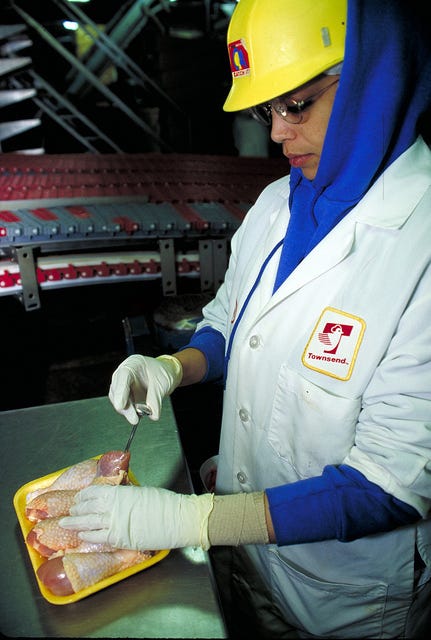New federal standards aim to reduce salmonella and campylobacter in ground chicken and turkey and chicken pieces.
February 5, 2016

The U.S. Department of Agriculture's Food Safety & Inspection Service (FSIS) announced the finalization of new federal standards to reduce salmonella and campylobacter in ground chicken and turkey products, as well as in raw chicken breasts, legs and wings. Based on scientific risk assessments, FSIS estimates that implementation of these standards will lead to an average of 50,000 prevented illnesses annually.
As part of this move to make frequently purchased chicken and turkey items safer for Americans to eat, FSIS has also updated its microbial testing schedule at poultry facilities and will soon begin posting more information online about individual companies' food safety performance.

U.S. Department of Agriculture (USDA) Food Safety Inspection Service (FSIS) inspector checks the temperature of chicken carcasses at various control points to compare them with those measured and recorded by the plant to prevent multiplication of pathogenic bacteria. USDA photo Lester Shepherd
"Over the past seven years, USDA has put in place tighter and more strategic food safety measures than ever before for meat and poultry products. We have made strides in modernizing every aspect of food safety inspection, from company recordkeeping to labeling requirements to the way we perform testing in our labs," Agriculture Secretary Tom Vilsack said. "These new standards, in combination with greater transparency about poultry companies' food safety performance and better testing procedures, will help prevent tens of thousands of foodborne illnesses every year, reaching our Healthy People 2020 goals."
FSIS uses pathogen reduction performance standards to assess the food safety performance of establishments that prepare meat and poultry products. By making the standards for ground poultry tougher to meet, ground poultry products nationwide will have less contamination and, therefore, should result in fewer foodborne illnesses.
FSIS implemented performance standards for whole chickens in 1996 but has since learned that salmonella levels increase as chicken is further processed into parts. Poultry parts like breasts, wings and others represent 80% of the chicken available for purchase in the U.S. By creating a standard for chicken parts and performing regulatory testing at a point closer to the final product, FSIS said it can greatly reduce consumer exposure to salmonella and campylobacter.
"This approach to poultry inspection is based on science, supported by strong data, and will truly improve public health," USDA deputy undersecretary for food safety Al Almanza said. "The new performance standards will complement the many other proactive, prevention-based food policies that we've put in place in recent years to make America's supply of meat and poultry safer to eat."
For chicken parts, ground chicken and ground turkey, FSIS is finalizing a pathogen reduction performance standard designed to achieve at least a 30% reduction in illnesses from salmonella. For chicken parts and ground chicken, FSIS is finalizing a pathogen reduction performance standard designed to achieve at least a 32% reduction in illnesses from campylobacter. Because FSIS has found the prevalence of campylobacter in ground turkey to be already low, the reduction for this product is estimated to be 19%.
After these standards were proposed in early 2015, FSIS began to use routine sampling throughout the year rather than infrequent sampling on consecutive days to assess whether an establishment's processes are effectively addressing salmonella and campylobacter. Once establishments have completed a full set of testing under the new standards, the agency will begin posting online which facilities pass, meet or fail the new standards.
An estimated 1.2 million foodborne illnesses are thought to be caused by salmonella every year, with approximately one-third (360,000) of those illnesses attributed to FSIS-regulated products. In 2013, the agency released a Salmonella Action Plan, which created a blueprint for the agency to address this pathogen of significant public health concern. Today's announcement fulfills the major steps FSIS had outlined in that plan.
Industry response
Industry members from the poultry and turkey industry said they have been working to reduce food safety concerns through modernization practices.
“Turkey companies are continually modernizing protections that inhibit bacteria during meat preparation, portioning and packaging. They have a well-documented record of successful innovation in food safety. We are using each proven advancement in science to counter the formation of pathogens. We are engaged in an ambitious, ongoing effort to lower the count of these microbes to the lowest point possible for raw meat and poultry products,” said Lisa Wallenda Picard, vice president for science and regulatory affairs of the National Turkey Federation.
The National Chicken Council (NCC) has been leading the Second Processing Working Group since the fall of 2013 to collectively explore all options to reduce contamination on chicken parts in order to provide the safest product possible to consumers, including strengthened sanitation programs, temperature controls and various interventions in both first and second processing.
“This is something the industry has been proactively working to address, so when the performance standards for chicken parts are put in place by FSIS, we will be meeting or exceeding the standards, as we currently do for whole carcasses,” said Dr. Ashley Peterson, senior vice president of scientific and regulatory affairs at NCC.
Peterson added that NCC’s members will continue to rely upon the best science, microbiology and technology available to reduce foodborne pathogens in order to meet and exceed standards set forth by the federal government. “We look forward to reviewing the final rule in its entirety,” she said.
You May Also Like

.png?width=300&auto=webp&quality=80&disable=upscale)

